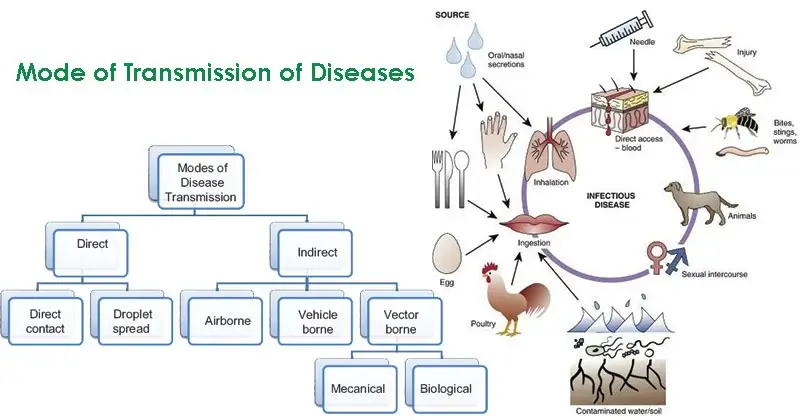- The traditional epidemiologic triad model holds that infectious diseases result from the interaction of agent, host, and environment.
- More specifically, transmission occurs when the agent leaves its reservoir or host through a portal of exit, is conveyed by some mode of transmission, and enters through an appropriate portal of entry to infect a susceptible host.
- An infectious agent may be transmitted from its natural reservoir to a susceptible host in different ways.
- There are different classifications for modes of transmission.
- Diseases can be transmitted directly or indirectly.

Image Source: Indian Journal of Health Sciences and Biomedical Research KLEU and Pinterest
Interesting Science Videos
Direct Transmission
- Direct transmission is the immediate transfer of the infectious agent from an infected host or reservoir to an appropriate entry point through which human infection can take place.
- This may be by direct contact such as touching, kissing or sexual intercourse, or by the direct spread of droplets by sneezing or coughing.
- Blood transfusions and transplacental infection from mother to fetus are other important means of direct transmission.
Direct Contact
- Direct contact occurs through skin-to-skin contact, kissing, and sexual intercourse.
- Direct contact also refers to contact with soil or vegetation harboring infectious organisms. Thus, infectious mononucleosis (“kissing disease”) and gonorrhea are spread from person to person by direct contact.
- Hookworm is spread by direct contact with contaminated soil.
Droplet Spread
- Droplet spread refers to spray with relatively large, short-range aerosols produced by sneezing, coughing, or even talking.
- Droplet spread is classified as direct because transmission is by direct spray over a few feet before the droplets fall to the ground.
- Pertussis and meningococcal infection are examples of diseases transmitted from an infectious patient to a susceptible host by droplet spread.
Direct Transmission Occurs By:
- Touching
- Kissing
- Sexual intercourse
- Other contacts (e.g. childbirth, medical procedures, injection of drugs, breastfeeding)
- Airborne, short-distance (via droplets, coughing, sneezing)
- Transfusion (blood)
- Trans-placental
Indirect Transmission
- Indirect transmission may be vehicle-borne, vector-borne or airborne.
- Vehicle-borne transmission occurs through contaminated materials such as food, clothes, bedding and cooking utensils.
- Vector-borne transmission occurs when the agent is carried by an insect or animal (the vector) to a susceptible host; the agent may or may not multiply in the vector.
- Long-distance airborne transmission occurs when there is the dissemination of very small droplets to a suitable point of entry, usually the respiratory tract. Dust particles also facilitate airborne transmission, for example, of fungal spores.
Vehicles
- Vehicles that may indirectly transmit an infectious agent include food, water, biologic products (blood), and fomites (inanimate objects such as handkerchiefs, bedding, or surgical scalpels).
- A vehicle may passively carry a pathogen — as food or water may carry the hepatitis A virus.
- Alternatively, the vehicle may provide an environment in which the agent grows, multiplies, or produces toxin — as improperly canned foods provide an environment that supports the production of botulinum toxin by Clostridium botulinum.
Vectors
- Vectors such as mosquitoes, fleas, and ticks may carry an infectious agent through purely mechanical means or may support growth or changes in the agent.
- Examples of mechanical transmission are flies carrying Shigella on their appendages and fleas carrying Yersinia pestis, the causative agent of plague, in their gut.
- In contrast, in biologic transmission, the causative agent of malaria or guinea worm disease undergoes maturation in an intermediate host before it can be transmitted to humans.
Airborne transmission
- It occurs when infectious agents are carried by dust or droplet nuclei suspended in the air.
- Airborne dust includes material that has settled on surfaces and become re-suspended by air currents as well as infectious particles blown from the soil by the wind.
- Droplet nuclei are dried residue of fewer than 5 microns in size.
- In contrast to droplets that fall to the ground within a few feet, droplet nuclei may remain suspended in the air for long periods of time and maybe blown over great distances. Measles, for example, has occurred in children who came into a physician’s office after a child with measles had left, because the measles virus remained suspended in the air.
Indirect Transmission Occurs By:
- Vehicle-borne (contaminated food, water, towels, farm tools, etc.)
- Vector-borne (insects, animals)
- Airborne, long-distance (dust, droplets) Parenteral (injections with contaminated syringes)
Significance of Mode of Transmission of Disease
- Breaking the chain at the ‘mode of transmission’ is one of the most important ways to interrupt the spread of infection. This is where infection prevention and control strategies can be most successful.
- It is important to distinguish between types of transmission when selecting control methods.
- Direct transmission can be interrupted by preventing contact with the source.
- Indirect transmission requires different approaches, such as the provision of mosquito nets, adequate ventilation, cold storage for foods or sterile syringes and needles.
References
- https://www.who.int/buruli/research/priorities/transmission/en/
- http://www.iaff.org/HS/Resi/infdis/What_are_the_modes_of_transmission.htm
- https://www.omicsonline.org/conferences-list/modes-of-transmission-of-infectious-diseases
- https://www.gov.nu.ca/sites/default/files/files/4_%20Modes%20of%20Transmission%20-%20march%205%20-%20low%20res.pdf
- https://www.cdc.gov/csels/dsepd/ss1978/lesson1/section10.html
- https://emedia.rmit.edu.au/infection_control/content/3_MethodTransmission/01_tran_de.htm
- Park, K. (n.d.). Park’s textbook of preventive and social medicine.
- Beaglehole, Robert, Bonita, Ruth, Kjellström, Tord & World Health Organization. (1993). Basic epidemiology, Updated reprint. World Health Organization.
- Gordis, L. (2014). Epidemiology (Fifth edition.). Philadelphia, PA: Elsevier Saunders.
